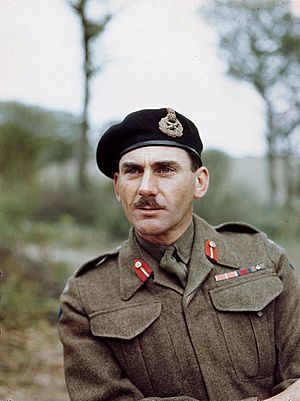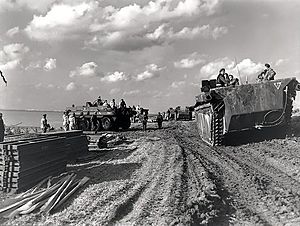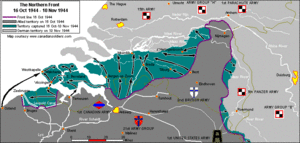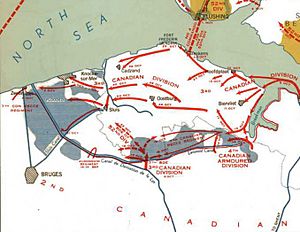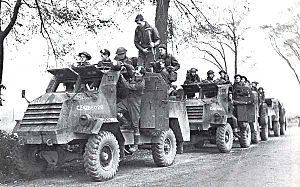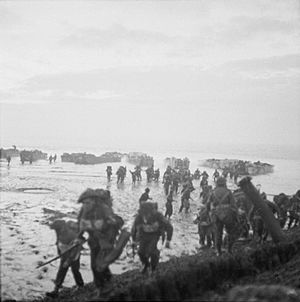Battle of the Scheldt facts for kids
Quick facts for kids Battle of the Scheldt |
|||||||||
|---|---|---|---|---|---|---|---|---|---|
| Part of the Allied advance from Paris to the Rhine in the Western Front of World War II | |||||||||
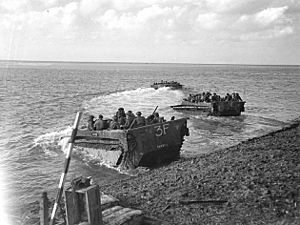
|
|||||||||
|
|||||||||
| Belligerents | |||||||||
| Commanders and leaders | |||||||||
|
|||||||||
| Units involved | |||||||||
| First Canadian Army | 15th Army | ||||||||
| Strength | |||||||||
| 450,000+ | 230,000 | ||||||||
| Casualties and losses | |||||||||
|
|
||||||||
The Battle of the Scheldt was a major series of military actions during World War II. It was led by the First Canadian Army, along with soldiers from Poland and Britain. Their goal was to clear the shipping route to the port city of Antwerp in Belgium. This port was super important because the Allied forces needed a way to bring in supplies for their fight in north-west Europe.
The battle happened in northern Belgium and the southwestern Netherlands from October 2 to November 8, 1944. Lieutenant-General Guy Simonds was in charge of the Canadian forces. The Allies faced tough German resistance. The Germans even flooded parts of the land to slow down the Allied advance. After five weeks of hard fighting, the Canadian First Army finally cleared the Scheldt. This victory came at a high cost, with 20,873 Allied soldiers killed or wounded, including 6,367 Canadians.
Once the Germans were defeated, it took another three weeks to remove naval mines from the harbor. The first supply ships arrived in Antwerp on November 29, 1944. This port then became a vital supply hub, bringing in millions of tons of supplies. These supplies were key to the Allies' successful push into Germany in 1945.
Contents
Why Antwerp Was So Important
After the Allies broke out of Normandy in France, they moved quickly into the Low Countries (Belgium and the Netherlands). But their supply lines were getting very long. Ports like Cherbourg were far away from the front lines, making it hard to get enough supplies to the soldiers.
Antwerp was a perfect solution. It's a deep-water port located close to Germany. Ships could reach it from the North Sea by sailing up the Scheldt river. After the city of Rotterdam was bombed in 1940, Antwerp became the largest working port in Western Europe. Everyone knew it would be essential for invading Germany.
Belgian resistance fighters, called the White Brigade, captured the port of Antwerp before the Germans could destroy it. On September 4, the 11th Armoured Division took Antwerp, and 90% of its harbor was still in good shape. However, the Germans had heavily fortified the Walcheren peninsula at the mouth of the Scheldt river. This area had strong artillery that could not be easily bombed from the air. This meant Allied ships couldn't clear the river and open the port. Walcheren was part of the Atlantic Wall, a huge line of German defenses.
Allied Plans and Challenges
On September 5, 1944, Admiral Sir Bertram Ramsay, a naval commander, told General Bernard Montgomery that opening the Scheldt was the most important task. He said that as long as the Germans controlled the river's mouth, Antwerp port was useless. Montgomery also learned that Adolf Hitler wanted to hold the Scheldt at all costs.
However, Montgomery was focused on another big plan called Operation Market Garden, which happened later that month. Only Admiral Ramsay truly understood how important opening Antwerp was for the Allies to keep moving into Germany. Montgomery also wanted his own army group to lead the invasion of Germany. He believed that one good port in France would be enough for his army. This meant Antwerp was not a top priority for him at first.
Because of these reasons, not much was done about Antwerp in September. Montgomery ordered the First Canadian Army to clear the Scheldt only after taking other French ports like Boulogne, Calais, and Dunkirk. Canadian General Harry Crerar said this was impossible because he didn't have enough soldiers. Montgomery refused to send more troops, as he needed them for Operation Market Garden. This delay allowed the German 15th Army to dig in and prepare their defenses.
German Defenses
The Walcheren peninsula was defended by German navy and army soldiers, led by General Wilhelm Daser. Their forces included coastal artillery, anti-aircraft guns, and infantry.
The Allies had tricked the Germans into thinking the main invasion would happen in a different part of France. Because of this, the German 15th Army in that area had been reinforced with many troops and supplies. These forces were then close to the Scheldt river's mouth.
Hitler ordered the 15th Army to hold the Scheldt river's mouth at all costs, calling Walcheren island "Fortress Walcheren." Even though the Germans were low on supplies because they were saving resources for another big attack, the flat, wet land of the Netherlands helped them defend. Field Marshal Gerd von Rundstedt told his general that holding the Scheldt was vital. He said that denying Antwerp to the Allies would stop their advance into Germany.
The Allied Attack Plan
Admiral Ramsay was deeply involved in planning the attack on Walcheren. He sent Captain Tony Pugsley of the Royal Navy to help the First Canadian Army prepare.
Montgomery finally decided that Antwerp was too important to delay. The First Canadian Army, under Lieutenant-General Guy Simonds, was given more troops, including British and Polish divisions. Simonds also got support from the RAF Bomber Command and the USAAF 8th Air Force to attack German defenses.
The plan to open the Scheldt Estuary had four main parts:
- Clearing the area north of Antwerp to reach the South Beveland peninsula.
- Operation Switchback: Clearing the Breskens Pocket (an area north of the Leopold canal and south of the Western Scheldt).
- Operation Vitality: Capturing the South Beveland peninsula.
- Operation Infatuate: Capturing Walcheren island.
The first attacks began on September 13. An early attempt by the 4th Canadian Armoured Division to cross the Leopold Canal failed badly. General Simonds then stopped operations until other French ports were taken, saying the Scheldt would need more soldiers. This pause gave the German 15th Army plenty of time to dig in.
Operation Switchback started on September 21. The 4th Canadian (Armoured) Division moved north to clear the "Breskens Pocket." The Polish 1st Armoured Division pushed towards the Dutch-Belgian border to clear the area north of Antwerp.
The Canadian 4th Armoured Division faced a tough challenge at the Leopold and Schipdonk Canals. An attack to cross the canals and set up a bridgehead failed with many casualties. The Polish 1st Armoured Division had more success, reaching the coast by September 20 and clearing the south bank of the Scheldt.
Simonds realized that taking the Scheldt would be very costly. The "Breskens Pocket" was strongly defended. In October, Montgomery moved some British and Polish divisions away from the First Canadian Army to help in another operation. Simonds believed he could still clear the Scheldt with fewer divisions, even against the entire German 15th Army in strong defensive positions. He never complained about lacking soldiers or supplies.
The Battle Begins
Securing Access to South Beveland
On October 2, the Canadian 2nd Division began moving north from Antwerp. Heavy fighting started on October 6 at Woensdrecht. The Germans saw this as a key point, controlling the way to South Beveland and Walcheren island. They fought hard to hold it.
The Canadians suffered many casualties attacking across open, flooded land. The weather was terrible, with driving rain, booby traps, and land mines making it very difficult. On October 7, the Calgary Highlanders faced heavy German fire. The Régiment de Maisonneuve was stopped short of its goal. The next day, The Black Watch of Canada also failed to advance. On October 9, the Germans counter-attacked and pushed the Canadians back.
Admiral Ramsay, concerned about the Canadians, told General Dwight Eisenhower that the Canadians were running out of ammunition. Eisenhower then told Montgomery that Antwerp was extremely important. Montgomery, upset, insisted there was no shortage of ammunition and that he was personally handling the operations.
The Germans sent more troops to Woensdrecht. On October 10, the Royal Regiment of Canada launched a surprise attack but faced strong counter-attacks for days. The fighting was tough, with many German snipers and rising floods.
Simonds had planned to use the 4th Division to help clear the Breskens Pocket. But problems with the 2nd Division forced him to send units from the 4th Division to help.
October 13 became known as "Black Friday." The Canadian 5th Infantry Brigade's Black Watch regiment was almost wiped out in a failed attack. The Black Watch had already suffered heavy losses in July 1944. An officer reported that new soldiers had little training and low morale. The Calgary Highlanders then took the railway station at Korteven. Fighting also happened at Hoogerheide. On October 16, The Royal Hamilton Light Infantry attacked Woensdrecht at night, taking most of the village. By October 16, Woensdrecht was secured, cutting off the land route to South Beveland and Walcheren. The Canadians had achieved their first goal but with heavy losses.
On October 14, Montgomery criticized Eisenhower's leadership. Eisenhower responded by saying Montgomery needed to obey orders or he would be fired. Montgomery then promised that Antwerp would be the top priority. He assigned the British 52nd Lowland Division to the First Canadian Army. Simonds was happy to have them and planned for them to play a key role in taking Walcheren island.
Meanwhile, Simonds gathered forces at the neck of the South Beveland peninsula. On October 20, the 4th Division attacked the Wouwsche Plantage area. The Lincoln and Welland Regiment and The Algonquin Regiment took Esschen in a surprise attack. On October 23, the Germans counter-attacked with powerful self-propelled guns, causing heavy losses to Canadian tanks. The fighting at Wouwsche Plantage was so important that Montgomery visited to push for speed, but the flat land made it impossible. The Canadians then moved towards Bergen op Zoom.
By October 24, Allied lines had pushed further out, preventing German counter-attacks from cutting off the 2nd Canadian Division, which was moving west towards Walcheren island.
Operation Switchback: Clearing the Breskens Pocket
The second main operation, Operation Switchback, involved fierce fighting to clear the Breskens Pocket. Here, the Canadian 3rd Infantry Division faced strong German resistance trying to cross the Leopold Canal. The area was also heavily flooded.
The Breskens Pocket was held by the German 64th Division, led by General Knut Eberding, an expert in defensive warfare. When the German 15th Army retreated in September 1944, many guns and ammunition ended up in the Breskens Pocket. This included many 20 mm anti-aircraft guns, which the Germans used like powerful machine guns, and 88 mm flak guns, known for destroying tanks.
While Montgomery focused on other battles, Eberding used three weeks to dig in his men. He was surprised the Allies didn't bomb the pocket more, allowing his defenses to be built easily. The flat, swampy land made the Breskens Pocket like an "island," with only a few raised roads connecting it to the mainland. The Germans had also blown up dykes to flood the land, forcing Canadians to advance only on these narrow roads.
Canadian intelligence underestimated the German forces, expecting them to retreat. However, Simonds understood the difficulty of the terrain. He planned to use amphibious vehicles called "Buffaloes" to move across the flooded land and outflank the Germans. He planned attacks at both the Leopold Canal and the rear of the pocket.
The attack began with two parts. The Canadian 3rd Division's 7th Brigade attacked across the Leopold Canal. The 9th Brigade launched an amphibious attack from the coast. The 7th Brigade was made up of regiments from western Canada, while the 9th Brigade was made of Highland regiments. The North Shore Regiment made a fake attack, while the Regina Rifles and Canadian Scottish Regiment made the main assault.
The 9th Highland Brigade was delayed because they were new to amphibious vehicles. The assault began on October 6, with support from artillery and Canadian-built Wasp Universal Carriers equipped with flamethrowers. Simonds hoped to surprise the Germans by using flamethrowers instead of a long bombardment. The Wasps fired flames across the Leopold Canal, allowing the 7th Brigade to cross. However, many Germans had dug in well and escaped the flames. One company of the Royal Montreal Regiment was almost destroyed. The Germans fired heavily with machine guns and mortars. Only a few Montrealers made it across. The Regina Rifles were delayed by heavy fire.
Two small footholds were made, but the Germans quickly counter-attacked. The fighting was very intense, with soldiers saying it was worse than anything they saw in Normandy. The Royal Winnipeg Rifles suffered heavy losses. The weather also made it harder, with heavy rain filling trenches. The Canadians couldn't advance much beyond their small bridgehead. Eberding, the German commander, ordered his men to "annihilate" the 7th Brigade, which cost his 64th Division many soldiers. The battle for the Leopold Canal was one of the bloodiest for Canada in World War II, with many killed and others suffering from battle exhaustion. Eberding even ordered that German soldiers who retreated without orders be executed.
The Canadian 9th Brigade used Terrapin and Buffalo amphibious vehicles, operated by British Royal Engineers. They planned to cross the Braakman Inlet and land behind the German lines. Despite delays due to difficult navigation, the Germans were surprised. The North Nova Scotia Highland regiment landed with no resistance and captured nine sleeping German soldiers. The Highland Light Infantry faced mud more than Germans.
The Germans quickly counter-attacked the Highland Brigade. The Stormont, Dundas and Glengarry Highland regiment fought for two days for the village of Hoofdplaat. The North Nova Scotia Highlanders took three days to capture Driewegen. Canadian artillery was very effective, causing heavy losses to German counter-attacks during the day. German night attacks were more successful.
The Canadian 10th Brigade crossed the Leopold Canal. The 3rd Division's 8th Brigade then moved south, opening a land supply route into the pocket. Eberding used his reserves in counter-attacks, and many of his units were severely weakened. Between October 10 and 15, the 64th Division made a "fighting retreat" to shorten its lines. The Canadian Scottish Regiment found the village of Eede empty but then came under heavy artillery fire. The Queen's Own Rifles took IJzendijke after it was abandoned.
The Canadian Army faced a shortage of infantry soldiers. This was because the Canadian government had promised only volunteers would fight overseas. With not enough volunteers, especially for infantry, the army was short on men. This meant Canadian officers were careful to avoid operations that would cause heavy losses.
On October 24, Montgomery visited the 3rd Division headquarters. He criticized their slow advance, saying the Breskens Pocket should have been cleared weeks ago. He called Canadian officers cowards for not wanting to take heavy losses. As a result, a British brigade was pulled out as punishment, and the 3rd Division was ordered to speed up.
Despite the need to avoid heavy losses, the 3rd Division began "intense combat." The Régiment de la Chaudière attacked Oostburg on October 24, losing an entire company but holding their ground. On October 25, the Queen's Own Rifles took Oostburg after a "wild bayonet charge." Despite strong German resistance, the Canadians steadily pushed them back. In the last days, German morale dropped, and more "deserters" were executed as soldiers wanted to surrender.
On November 1, the North Nova Scotia Highlanders captured Eberding, the German commander, who surrendered without a fight. Eberding later told the Canadian general that he was not aggressive enough, saying German generals would have moved faster. The Canadian general replied that he preferred a careful approach to save his men's lives.
Operation Switchback ended on November 3. The Canadian 1st Army freed the Belgian towns of Knokke and Zeebrugge, officially closing the Breskens Pocket and removing all German forces south of the Scheldt.
Operation Vitality: Taking South Beveland
On October 22, Major-General Foulkes told the 2nd Canadian Division that Operation Vitality, the plan to take the South Beveland peninsula, would start two days earlier. This was a direct order from Field Marshal Montgomery. Morale in the 2nd Division was low because the men were tired from earlier fighting. Many regiments were also short on soldiers.
This third major operation began on October 24. The 2nd Canadian Infantry Division started its advance down the South Beveland peninsula. The Canadians hoped to move quickly, but they were slowed by mines, mud, and strong German defenses.
The fighting was tough. The Fusiliers Mont-Royal suffered "heavy casualties." The Cameron Highlanders faced "stiff opposition" from German paratroopers. The South Saskatchewan Regiment reported that the land was very difficult to attack across. On October 25, the Essex Scottish Regiment reported that 120 Germans had surrendered, and the "tough shell of defenses" at the narrowest point of the peninsula was broken. On October 26, the German commander, General Wilhelm Daser, reported that their position was impossible to hold.
A British division made an amphibious attack across the Western Scheldt to get behind the German defenses. They found the Dutch countryside "extremely difficult" but noted that German morale was poor. Most of their casualties came from mines and booby-traps. With the German defenses outflanked, the Canadian 6th Infantry Brigade launched a frontal attack. Engineers were able to build a bridge over the canal.
Once the canal line was broken, the German defense fell apart, and South Beveland was cleared. The third part of the Battle of the Scheldt was now complete. Daser ordered his men to retreat and make a final stand on "Fortress Walcheren."
Operation Infatuate: Capturing Walcheren Island
As the fourth part of the battle began, only Walcheren island remained in German hands. The island had extremely strong defenses: heavy coastal batteries and strong fortified coastlines. There was also a defensive line around the town of Flushing (Dutch: Vlissingen). The only land approach was the Sloedam, a long, narrow causeway from South Beveland. The surrounding flats were too wet to walk on but not deep enough for boats.
Flooding Walcheren
To make German defense harder, the Allies decided to breach Walcheren island's dykes by bombing them. This was a risky plan for the local people, so leaflets were dropped to warn them. The first bombing was on October 3 at Westkapelle, on the western shore. Bombers created a huge gap, flooding the central part of the island. This allowed amphibious vehicles to be used and forced German defenders onto higher ground. The bombing at Westkapelle caused 180 civilian deaths. Other dykes were bombed on October 7 and 11 to ensure the flooding could not be stopped.
The island was then attacked from three sides: across the Sloedam causeway from the east, across the Scheldt from the south, and by sea from the west.
Battle of Walcheren Causeway
The 2nd Canadian Infantry Division attacked the Sloedam causeway on October 31. The Royal Regiment took the eastern end of the causeway in a night attack. The Black Watch regiment then tried to advance down the causeway but was pushed back. The water in the channel was too shallow for the 2nd Division to cross by boat. A company of the Black Watch was stranded under heavy German attack. The Calgary Highlanders also tried but were stopped halfway.
On November 1, the Highlanders gained a small foothold. After a day of fighting, the Régiment de Maisonneuve took over, securing the bridgehead. However, it was useless for a full advance because German defenses in the flooded land were too strong.
Major-General Hakewill-Smith of the 52nd Division was ordered to launch a frontal attack on Walcheren. He protested and instead outflanked the Germans by landing the Cameronian regiment south of the causeway. They linked up with the Glasgow Highlanders the next day. The battle for the causeway cost the 2nd Division 135 lives.
Captain Pugsley of the Royal Navy had to improvise to get enough ships for the Walcheren landings. Despite bad weather, the landings went ahead on November 1. Simonds ordered two Canadian artillery regiments to fire 300 guns from the mainland to support the landings.
Operation Infatuate I
Operation Infatuate I involved infantry from the 155th Infantry Brigade and No. 4 Commando. They were ferried from Breskens to a beach near Flushing. With Canadian artillery firing, the 4th Commando landed, followed by the King's Own Scottish Borderers, who attacked Flushing. For days, they fought fiercely in the streets, destroying much of the town. The Hotel Britannia, a German headquarters, saw "spectacular fighting" before it fell after three days.
Operation Infatuate II
Operation Infatuate II was the amphibious landing at Westkapelle on November 1. To cross the shallow water, a daylight attack was needed, supported by naval ships like the battleship HMS Warspite. Bad weather limited air support. German coastal artillery fired heavily, sinking 9 British ships and badly damaging 11 others. After a heavy naval bombardment, troops of the 4th Special Service Brigade (Royal Marines Commandos and No. 10 Inter Allied Commando) landed. They were supported by special armored vehicles like amphibious transports and mine-clearing tanks. The Royal Marines took Westkapelle and Domburg the next day. On November 4, mine-sweepers began clearing the Scheldt river, a task that took until November 28.
Heavy fighting continued in Domburg before it was captured. By November 3, the Royal Marines had linked up with the 52nd Division. Some troops moved towards Flushing, while the main force cleared the northern part of Walcheren. Fierce German resistance continued until November 7.
On November 6, the island capital of Middelburg fell. Royal Scots attacked Middelburg with amphibious "Buffaloes," forcing an end to all German resistance on November 8. The German general surrendered, claiming he was overwhelmed by "tanks" (the Buffaloes), which gave him an excuse to give up.
Meanwhile, the Canadian 4th Armoured Division had pushed past Bergen-op-Zoom to Sint Philipsland, sinking several German ships.
With the approach to Antwerp clear, the fourth phase of the Battle of the Scheldt was complete. Between November 20 and 28, Royal Navy mine-sweepers cleared the Scheldt Estuary. On November 28, after repairs, the first convoy entered Antwerp, led by the Canadian-built freighter Fort Cataraqui.
Aftermath of the Battle
At the end of the five-week battle, the Canadian First Army had captured 41,043 German prisoners. The Battle of the Scheldt was a very difficult campaign due to the wet, muddy land, and the Canadians suffered significant losses.
During the battle, many Canadian soldiers suffered from battle exhaustion. The 3rd Canadian Division had been fighting almost non-stop since D-Day in June 1944. A report from October 1944 found that most cases of battle exhaustion were among men who had been fighting for three months or longer. Soldiers would sometimes become unresponsive, but most recovered after a week of rest. The main reasons for exhaustion were feeling hopeless, a lack of safe cover on the battlefield, and seeing too much death and loss of friends.
The Canadian government's policy of only sending volunteers overseas led to a shortage of infantry soldiers. Canadian units were often under-strength and couldn't get enough rest or replacements. Soldiers complained that they were being pushed too hard without new men to fill the gaps.
After the battle, the Canadian II Corps moved to another sector. Although Antwerp was opened on November 28, the German 15th Army had delayed its use for over two months. This delay was longer than Hitler had hoped for. The heavy losses in the Battle of the Scheldt also contributed to a political crisis in Canada about conscription (forcing people to join the military). The Canadian Defence Minister had to tell the prime minister that the volunteer-only policy was not working, and conscripts would be needed.
Historians have praised General Simonds' leadership during the battle, calling his plans "brilliantly planned and sometimes brilliantly executed." They also defended the Canadians from criticism, saying that the Canadian Army had the most difficult and important task among the Allies in October. They carried out complex operations successfully despite a growing shortage of soldiers.
Even after Antwerp was opened, other Allied offensives struggled due to supply shortages. Eisenhower calculated that millions of artillery shells, mortar shells, and thousands of vehicles were needed. These supplies were not readily available until the Scheldt was cleared.
Germany knew how important Antwerp was. They fired more V-2 rockets at Antwerp than any other city. Nearly half of all V-2 rockets launched during the war were aimed at Antwerp. The port was so vital that during the Battle of the Bulge, the last major German attack in December 1944, the main German goal was to retake Antwerp and its port. Without Antwerp being open, which allowed 2.5 million tons of supplies to arrive between November 1944 and April 1945, the Allied advance into Germany in 1945 would have been impossible.
See also
- Rifleman Khan
- The Forgotten Battle (2020), a Dutch film about the Battle of the Scheldt
Images for kids


